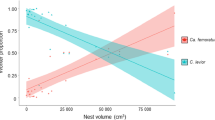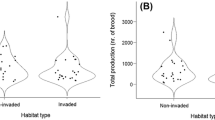Abstract
Organisms acquire energy from environment and must allocate it among different life traits (growth, maintenance and reproduction). Social insects must manage the energy allocation to various levels such as colony growth and caste functions. Here, we addressed the question of whether resource density affects the energy allocation to the number of individuals and caste functions as well as nest’s growth rate in the Neotropical termite Nasutitermes aff. coxipoensis (Homgren) (Termitidae: Nasutitermitinae). In a manipulative field experiment, colonies of N. aff. coxipoensis, with known volume, were maintained in plots with three different resource’s density (0.32, 0.64 and 1.92 baits/m2) over 3 months. After this period, the number of individuals as well as the caste identity and nest volume were measured. Surprisingly, our results showed that colonies reared in the extremes of resource’s density (0.32 and 1.92 baits/m2) produced a higher number of individuals compared with colonies reared with intermediate resource density (0. 64 baits/m2). The mean number of workers increased linearly with resource density; however, the average number of immature was higher in colonies reared with 0.32 baits/m2 compared with colonies reared with 0.64 and 1.92 baits/m2. No significant differences of resource density were observed in the mean number of soldiers, worker/soldier ratio as well as in the nest’s growth rate. In conclusion, the resource’s density seems to play an important role in determining the investment of energy in the number of individuals and caste in N. aff. coxipoensis colonies.



Similar content being viewed by others
References
Abe T (1987) Evolution of life types in termites. In: Kawano S, Connell J, Hidaka T (eds) Evolution and coadaptation in biotic communities. University of Tokyo Press, Tokyo, pp 125–148
Almeida CS, Cristaldo PF, Florencio DF, et al (2016) Combined foraging strategy and soldier behaviour in Nasutitermes aff. coxipoensis (Blattodea: Termitoidea: Termitidae)
Araújo APA, Araújo FS, Desouza O (2011) Resource suitability affecting foraging area extension in termites (Insecta, Isoptera). Sociobiology 57:1–14
Aron S, Keller L, Passera L (2009) Role of resource availability on sex, caste and reproductive allocation ratios in the Argentine ant Linepithema humile. J Anim Ecol 70:831–839
Bazzaz F, Chiariello N, Coley P, Pitelka L (1987) Allocating resources to reproduction and defense. Bioscience 37:58–67
Bloom AJ (2012) Integrated whole organism physiology. In: Hastings A, Gross L (eds) Encyclopedia of theoretical ecology. University of California Press, California, pp 376–381
Boulogne I, Constantino R, Amusant N, et al (2016) Ecology of termites from the genus Nasutitermes (Termitidae: Nasutitermitinae) and potential for science-based development of sustainable pest management programs. J Pest Sci 90:19-37
Carvell C, Rothery P, Pywell RF, Heard MS (2008) Effects of resource availability and social parasite invasion on field colonies of Bombus terrestris. Ecol Entomol 33:321–327
Cristaldo PF, Araújo APA, Almeida CS et al (2016) Resource availability influences aggression and response to chemical cues in the Neotropical termite Nasutitermes aff. coxipoensis (Termitidae: Nasutitermitinae). Behav Ecol Sociobiol 70:1257–1265
Crawley MJ (2007) The R book. John Wiley and Sons
Dukas R, Edelstein-Keshet L (1998) The spatial distribution of colonial food provisioners. J Theor Biol 190:121–134
Gadgil M, Bossert W (1970) Life historical consequences of natural selection. Am Nat 104:1–24
Grimaldi D, Engel M (2005) Evolution of the insects. Cambridge University Press
Haverty M (1977) The proportion of soldiers in termite colonies: a list and bibliography (Isoptera). Sociobiology 2:199–216
Haverty M (1979) Soldier production and maintenance of soldier proportions in laboratory experimental groups of Coptotermes formosanus Shiraki. Insect Soc 26:69–84
Houston A, Schimid-Hempel P, Kacelnik A (1988) Foraging strategy, worker mortality, and the growth of the colony in social insects. Am Nat 131:107–114
Howard R, Haverty MI (1981) Seasonal variations in caste proportions of field colonies of Reticulitermes flavipes (Kollar). Environ Entomol 10:546–549
Hunt JM, Nalepa CA (1994) Nourishment, evolution and insect sociality. In: Hunt JH, Nalepa CA (eds) Nourishment and evolution in insects societies. IBH Publishing, Oxford, pp 1–19
Kaspari M, Byrne MM (1995) Caste allocation in litter Pheidole: lessons from plant defense theory. Behav Ecol Sociobiol 37:255–263
Korb J (2004) Reproductive decision-making in the termite, Cryptotermes secundus (Kalotermitidae), under variable food conditions. Behav Ecol 15:390–395
Korb J, Katrantzis S (2004) Influence of environmental conditions on the expression of the sexual dispersal phenotype in a lower termite: implications for the evolution of workers in termites. Evol Dev 6:342–352
Korb J, Schmidinger S (2004) Help or disperse? Cooperation in termites influenced by food conditions. Behav Ecol Sociobiol 56:89–95
Legendre F, Whiting MF, Bordereau C et al (2008) The phylogeny of termites (Dictyoptera: Isoptera) based on mitochondrial and nuclear markers: implications for the evolution of the worker and pseudergate castes, and foraging behaviors. Mol Phylogenet Evol 48:615–627
Lenz M (1994) Food resources, colony growth and caste development in wood-feeding termites. In: Hunt JM, Nalepa CA (eds) Nourishment and evolution in insects societies 1. IBH Publishing, Oxford, pp 159–209
Mathews A (1977) Studies on termites from the Mato Grosso State, Brazil. Academia Brasileira de Ciências
Noirot C, Darlington JPEC (2000) Termite nests: architecture, regulation and defense. In: Abe T, Bignell DE, Higashi M (eds) Termites: evolution, sociality, symbioses, ecology. Springer, Netherlands, pp 121–139
Orians G, Pearson NE (1979) On the theory of central place foraging. In: Horn DMRSG (ed) Analysis of ecological systems. Ohio University Press, Ohio, pp 155–177
Oster G, Wilson E (1978) Caste and ecology in the social insects. Princeton University Press, Princeton
Powell S (2009) How ecology shapes caste evolution: linking resource use, morphology, performance and fitness in a superorganism. J Evol Biol 22:1004–1013
Seeley TD, Mikheyeva S (2003) Reproductive decisions by honey bee colonies: tuning investment in male production in relation to success in energy acquisition. Insect Soc 50:134–138
Smith AR, López Quintero IJ, Moreno Patiño JE et al (2012) Pollen use by Megalopta sweat bees in relation to resource availability in a tropical forest. Ecol Entomol 37:309–317
Stearns S (1989) Trade-offs in life-history evolution. Funct Ecol 3:259–268
Thorne BL (1984) Polygyny in the Neotropical termite Nasutitermes corniger: life history consequences of queen mutualism. Behav Ecol Sociobiol 14:117–136
Thorne BL, Haverty MI (2000) Nest growth and survivorship in three species of neotropical Nasutitermes (Isoptera: Termitidae). Environ Entomol 29:256–264
Wills BD, Chong CD, Wilder SM et al (2015) Effect of carbohydrate supplementation on investment into offspring number, size, and condition in a social insect. PLoS One 10:e0132440
Wilson E (1971) The insect societies. Belknap Press of Harvard University Press. MA, Cambridge
Acknowledgements
We thank Prof. Reginaldo Constantino (UnB) for species identification, the staff of Santa Isabel Biological Reserve (REBIO/ICMBio) to logistic support and to colleagues from Clinica Fitossanitária-UFS for all help in the field. The Brazilian National Research Council (CNPq) support A.P.A.A (#484823/2013-2) and P.F.C is supported by CNPq/FAPITEC-SE (#302246/2014-2). The other co-authors were supported by CAPES or CNPq grants.
Author information
Authors and Affiliations
Corresponding author
Additional information
Edited by Fabio S Nascimento – FFCLRP/USP
Rights and permissions
About this article
Cite this article
Cristaldo, P.F., Almeida, C.S., Cruz, N.G. et al. The Role of Resource Density on Energy Allocation in the Neotropical Termite Nasutitermes aff. coxipoensis (Termitidae: Nasutitermitinae). Neotrop Entomol 47, 329–335 (2018). https://doi.org/10.1007/s13744-017-0525-z
Received:
Accepted:
Published:
Issue Date:
DOI: https://doi.org/10.1007/s13744-017-0525-z




